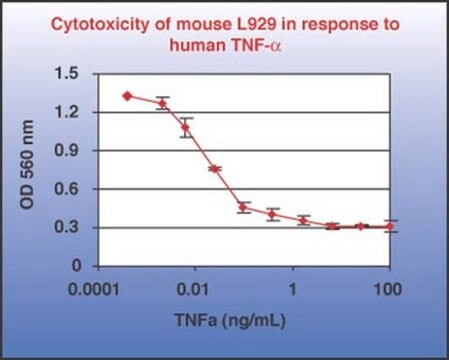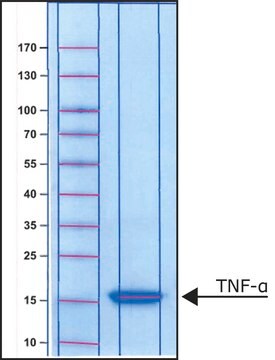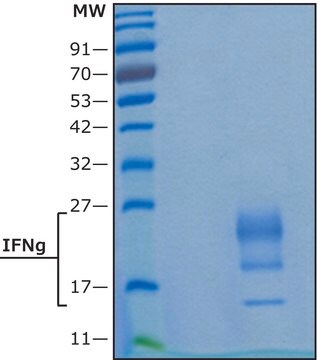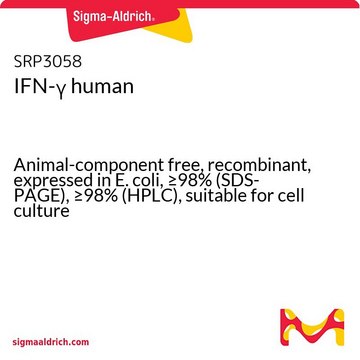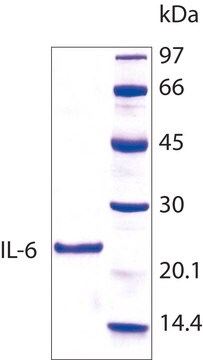추천 제품
생물학적 소스
human
Quality Level
재조합
expressed in HEK 293 cells
분석
≥95% (SDS-PAGE)
형태
lyophilized powder
효능
≤1.0 ng/mL ED50
품질
endotoxin tested
분자량
17 kDa (glycosylated)
~17.4 kDa
포장
pkg of 10 μg
저장 조건
avoid repeated freeze/thaw cycles
기술
cell culture | mammalian: suitable
불순물
≤1.00 EU/μg (endotoxin)
UniProt 수납 번호
저장 온도
−20°C
유전자 정보
human ... TNF(7124)
유사한 제품을 찾으십니까? 방문 제품 비교 안내
일반 설명
The TNFα (tumor necrosis factor α) gene is mapped to human chromosome 6p21.33. TNFα is a member of TNF superfamily. TNF-α has a palmitoyl group in the cysteine residue and is phosphorylated in the transmembrane region serine residue.
애플리케이션
Tumor Necrosis Factor-α (TNF-α) human has been used
- In induction of netting neutrophils by anti-neutrophil cytoplasmic antibody and to study its effect on platelet activation and formation of monomeric C-reactive protein.
- To study the effect of TNF-α on miR-221 and fractalkine expression.
- To induce inflammatory cell responses.
- In NF-κB luciferase reporter assay.
Tumor Necrosis Factor-a human has been used:
- as a permeability inducing agent for endothelial cell monolayer permeability assay
- as a reactive oxygen species inducer in primary rat cardiac microvascular endothelial cells (RCMVECs)
- in the activation of nuclear factor kappa B (NF-κB) in human embryonic kidney cells (HEK293), neuroblastoma SH-SY5Y cells and HeLa cells
- in the stimulation of the human keratinocyte cell line(HaCaT) and human coronary artery endothelial cells (HCAECs)
생화학적/생리학적 작용
Tumor Necrosis Factor-α (TNF-α) is a potent pro-inflammatory cytokine that plays a role in the rheumatoid arthritis pathology, psoriatic arthritis (PsA) and psoriasis. It stimulates interleukins IL-1 and IL-6. Polymorphism in the TNF-α gene is associated with destructive arthropathy in PsA. The post-translational modifications in TNF-a is crucial for its functionality.
Tumore necrosis factor-α (TNF-α), also known as cachectin, is expressed as a 26 kDa membrane bound protein and is then cleaved by TNF-α converting enzyme (TACE) to release the soluble 17 kDa monomer, which forms homotrimers in circulation. TNF-α plays roles in antitumor activity, immune modulation, inflammation, anorexia, cachexia, septic shock, viral replication and hematopoiesis. TNF-α is expressed by a great variety of cells, with numerous inductive and suppressive agents. Primarily, TNF-α is produced by macrophages in response to immunological challenges such as bacteria (lipopolysaccharides), viruses, parasites, mitogens and other cytokines. TNF-α is cytotoxic for many transformed cells (its namesake activity) but in normal diploid cells, it can stimulate proliferation (fibroblasts), differentiation (myeloid cells) or activation (neutrophils). TNF-α also shows antiviral effects against both DNA and RNA viruses and it induces production of several other cytokines. Although TNF-α is used in clinical trials as an antitumor agent, Sigma′s cytokine, growth factor and hormone products are for research only. TNF-α and the related molecule TNF-β (LT-α) share close structural homology with 28% amino acid sequence identity and both activate the same TNF receptors, TNFR1 and TNFR2. Mouse and human TNF-α share 79% amino acid sequence identity. Unlike human TNF-α, the mouse form is N-glycosylated.
제조 메모
Tumor Necrosis Factor-α (TNF-α) is expressed in human HEK 293 cells and has been shown to be predominantly a glycosylated, non-covalently linked homotrimer with a molecular mass of 51 kDa (gel filtration). Production in human 293 cells offers authentic glycosylation. Glycosylation contributes to stability in cell growth media and other applications.
분석 메모
The specific activity was determined by the dose-dependent cytotoxity of the TNF alpha sensitive cell line L-929 in the presence of actinomycin D.
Storage Class Code
11 - Combustible Solids
WGK
WGK 2
Flash Point (°F)
Not applicable
Flash Point (°C)
Not applicable
시험 성적서(COA)
제품의 로트/배치 번호를 입력하여 시험 성적서(COA)을 검색하십시오. 로트 및 배치 번호는 제품 라벨에 있는 ‘로트’ 또는 ‘배치’라는 용어 뒤에서 찾을 수 있습니다.
C-reactive protein enhances activation of coagulation system and inflammatory response through dissociating into monomeric form in antineutrophil cytoplasmic antibody-associated vasculitis
Xu PC, et al.
BMC Immunology, 16.1 (2015)
LSHGD: A database for human leprosy susceptible genes
Doss CGP, et al.
Genomics, 100, 162-166 (2012)
Thioredoxin 2 is a Novel E2-Interacting Protein that Inhibits the
2 Replication of Classical Swine Fever Virus
2 Replication of Classical Swine Fever Virus
Li Su, et al.
Journal of Virology (2015)
Association between TNFβ - 308 G/A polymorphism and oral lichen planus (OLP): a meta-analysis
Zhou Y and Vieira AR
Journal of Applied Oral Science : Revista FOB, 26 (2018)
Dhanush Haspula et al.
Frontiers in physiology, 10, 558-558 (2019-05-28)
Hyperglycemia is a critical factor in the development of endothelial dysfunction in type 2 diabetes mellitus (T2DM). Whether hyperglycemic states result in a disruption of similar molecular mechanisms in endothelial cells under both diabetic and non-diabetic states, remains largely unknown.
문서
Lipid Induced Insulin Resistance
자사의 과학자팀은 생명 과학, 재료 과학, 화학 합성, 크로마토그래피, 분석 및 기타 많은 영역을 포함한 모든 과학 분야에 경험이 있습니다..
고객지원팀으로 연락바랍니다.
